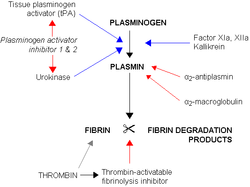
Urokinase
Encyclopedia
Urokinase also called urokinase-type plasminogen activator (uPA), is a serine protease
. Urokinase was originally isolated from human urine
, but is present in several physiological locations, such as blood stream and the extracellular matrix
. The primary physiological substrate is plasminogen, which is an inactive zymogen
form of the serine protease plasmin
. Activation of plasmin triggers a proteolysis cascade that, depending on the physiological environment, participates in thrombolysis
or extracellular matrix
degradation. This links urokinase to vascular diseases and cancer.
protein
, consisting of three domains
: the serine protease domain, the kringle domain
, and the growth factor domain. Urokinase is synthesized as a zymogen form (prourokinase or single-chain urokinase), and is activated by proteolytic cleavage between L158 and I159. The two resulting chains are kept together by a disulfide
bond.
s plasminogen activator inhibitor-1
(PAI-1) and plasminogen activator inhibitor-2
(PAI-2), which inhibit the protease activity irreversibly. In the extracellular matrix, urokinase is tethered to the cell membrane
by its interaction to the urokinase receptor
.

levels of urokinase and several other components of the plasminogen activation system are found to be correlated with tumor
malignancy. It is believed that the tissue degradation following plasminogen activation facilitates tissue invasion and, thus, contributes to metastasis
. This makes urokinase an attractive drug target, and, so, inhibitor
s have been sought to be used as anticancer agents. However, incompatibilities between the human and murine systems hamper clinical evaluation of these agents. Through its interaction with the urokinase receptor
, urokinase affects several other aspects of cancer biology such as cells adhesion, migration, and cellular mitotic pathways.
agent in the treatment of severe or massive deep venous thrombosis, pulmonary embolism
, myocardial infarction
, and occluded intravenous or dialysis
cannulas. It is also administered intrapleurally to improve the drainage of complicated pleural effusions and empyemas. Urokinase is presently marketed as KinlyticTM, and competes with AlteplaseTM
as a thrombolytic drug in infarctation.
Serine protease
Serine proteases are enzymes that cleave peptide bonds in proteins, in which serine serves as the nucleophilic amino acid at the active site.They are found ubiquitously in both eukaryotes and prokaryotes...
. Urokinase was originally isolated from human urine
Urine
Urine is a typically sterile liquid by-product of the body that is secreted by the kidneys through a process called urination and excreted through the urethra. Cellular metabolism generates numerous by-products, many rich in nitrogen, that require elimination from the bloodstream...
, but is present in several physiological locations, such as blood stream and the extracellular matrix
Extracellular matrix
In biology, the extracellular matrix is the extracellular part of animal tissue that usually provides structural support to the animal cells in addition to performing various other important functions. The extracellular matrix is the defining feature of connective tissue in animals.Extracellular...
. The primary physiological substrate is plasminogen, which is an inactive zymogen
Zymogen
A zymogen is an inactive enzyme precursor. A zymogen requires a biochemical change for it to become an active enzyme. The biochemical change usually occurs in a lysosome where a specific part of the precursor enzyme is cleaved in order to activate it...
form of the serine protease plasmin
Plasmin
Plasmin is an important enzyme present in blood that degrades many blood plasma proteins, most notably, fibrin clots. The degradation of fibrin is termed fibrinolysis. In humans, the plasmin protein is encoded by the PLG gene.- Function :...
. Activation of plasmin triggers a proteolysis cascade that, depending on the physiological environment, participates in thrombolysis
Thrombolysis
Thrombolysis is the breakdown of blood clots by pharmacological means. It is colloquially referred to as clot busting for this reason...
or extracellular matrix
Extracellular matrix
In biology, the extracellular matrix is the extracellular part of animal tissue that usually provides structural support to the animal cells in addition to performing various other important functions. The extracellular matrix is the defining feature of connective tissue in animals.Extracellular...
degradation. This links urokinase to vascular diseases and cancer.
Molecular characteristics
Urokinase is a 411-residueResidue (chemistry)
In chemistry, residue is the material remaining after a distillation or an evaporation, or to a portion of a larger molecule, such as a methyl group. It may also refer to the undesired byproducts of a reaction....
protein
Protein
Proteins are biochemical compounds consisting of one or more polypeptides typically folded into a globular or fibrous form, facilitating a biological function. A polypeptide is a single linear polymer chain of amino acids bonded together by peptide bonds between the carboxyl and amino groups of...
, consisting of three domains
Domain (biology)
In biological taxonomy, a domain is the highest taxonomic rank of organisms, higher than a kingdom. According to the three-domain system of Carl Woese, introduced in 1990, the Tree of Life consists of three domains: Archaea, Bacteria and Eukarya...
: the serine protease domain, the kringle domain
Kringle domain
Kringle Domains are autonomous protein domains that fold into large loops stabilized by 3 disulfide linkages. These are important in protein-protein interactions with blood coagulation factors...
, and the growth factor domain. Urokinase is synthesized as a zymogen form (prourokinase or single-chain urokinase), and is activated by proteolytic cleavage between L158 and I159. The two resulting chains are kept together by a disulfide
Disulfide
In chemistry, a disulfide usually refers to the structural unit composed of a linked pair of sulfur atoms. Disulfide usually refer to a chemical compound that contains a disulfide bond, such as diphenyl disulfide, C6H5S-SC6H5....
bond.
Interaction partners
The most important inhibitors of urokinase are the serpinSerpin
Serpins are a group of proteins with similar structures that were first identified as a set of proteins able to inhibit proteases. The acronym serpin was originally coined because many serpins inhibit chymotrypsin-like serine proteases .The first members of the serpin superfamily to be extensively...
s plasminogen activator inhibitor-1
Plasminogen activator inhibitor-1
Plasminogen activator inhibitor-1 also known as endothelial plasminogen activator inhibitor or serpin E1 is a protein that in humans is encoded by the SERPINE1 gene....
(PAI-1) and plasminogen activator inhibitor-2
Plasminogen activator inhibitor-2
Plasminogen activator inhibitor-2 is a coagulation factor that inactivates tPA and urokinase. It is present in most cells, especially monocytes/macrophages...
(PAI-2), which inhibit the protease activity irreversibly. In the extracellular matrix, urokinase is tethered to the cell membrane
Cell membrane
The cell membrane or plasma membrane is a biological membrane that separates the interior of all cells from the outside environment. The cell membrane is selectively permeable to ions and organic molecules and controls the movement of substances in and out of cells. It basically protects the cell...
by its interaction to the urokinase receptor
Urokinase receptor
The Urokinase receptor, also known as uPA receptor or uPAR or CD87 , is multidomain glycoprotein tethered to the cell membrane with a glycosylphosphotidylinositol anchor...
.

Urokinase and cancer
Elevated expressionGene expression
Gene expression is the process by which information from a gene is used in the synthesis of a functional gene product. These products are often proteins, but in non-protein coding genes such as ribosomal RNA , transfer RNA or small nuclear RNA genes, the product is a functional RNA...
levels of urokinase and several other components of the plasminogen activation system are found to be correlated with tumor
Tumor
A tumor or tumour is commonly used as a synonym for a neoplasm that appears enlarged in size. Tumor is not synonymous with cancer...
malignancy. It is believed that the tissue degradation following plasminogen activation facilitates tissue invasion and, thus, contributes to metastasis
Metastasis
Metastasis, or metastatic disease , is the spread of a disease from one organ or part to another non-adjacent organ or part. It was previously thought that only malignant tumor cells and infections have the capacity to metastasize; however, this is being reconsidered due to new research...
. This makes urokinase an attractive drug target, and, so, inhibitor
Enzyme inhibitor
An enzyme inhibitor is a molecule that binds to enzymes and decreases their activity. Since blocking an enzyme's activity can kill a pathogen or correct a metabolic imbalance, many drugs are enzyme inhibitors. They are also used as herbicides and pesticides...
s have been sought to be used as anticancer agents. However, incompatibilities between the human and murine systems hamper clinical evaluation of these agents. Through its interaction with the urokinase receptor
Urokinase receptor
The Urokinase receptor, also known as uPA receptor or uPAR or CD87 , is multidomain glycoprotein tethered to the cell membrane with a glycosylphosphotidylinositol anchor...
, urokinase affects several other aspects of cancer biology such as cells adhesion, migration, and cellular mitotic pathways.
Clinical applications
Urokinase is used clinically as a thrombolyticThrombolysis
Thrombolysis is the breakdown of blood clots by pharmacological means. It is colloquially referred to as clot busting for this reason...
agent in the treatment of severe or massive deep venous thrombosis, pulmonary embolism
Pulmonary embolism
Pulmonary embolism is a blockage of the main artery of the lung or one of its branches by a substance that has travelled from elsewhere in the body through the bloodstream . Usually this is due to embolism of a thrombus from the deep veins in the legs, a process termed venous thromboembolism...
, myocardial infarction
Myocardial infarction
Myocardial infarction or acute myocardial infarction , commonly known as a heart attack, results from the interruption of blood supply to a part of the heart, causing heart cells to die...
, and occluded intravenous or dialysis
Dialysis
In medicine, dialysis is a process for removing waste and excess water from the blood, and is primarily used to provide an artificial replacement for lost kidney function in people with renal failure...
cannulas. It is also administered intrapleurally to improve the drainage of complicated pleural effusions and empyemas. Urokinase is presently marketed as KinlyticTM, and competes with AlteplaseTM
Tissue plasminogen activator
Tissue plasminogen activator is a protein involved in the breakdown of blood clots. It is a serine protease found on endothelial cells, the cells that line the blood vessels. As an enzyme, it catalyzes the conversion of plasminogen to plasmin, the major enzyme responsible for clot breakdown...
as a thrombolytic drug in infarctation.

